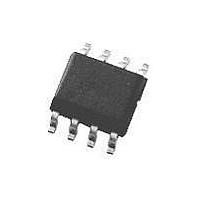LP2989AIM-5.0 National Semiconductor, LP2989AIM-5.0 Datasheet - Page 15

LP2989AIM-5.0
Manufacturer Part Number
LP2989AIM-5.0
Description
IC, LDO VOLT REG, 5V, 0.5A, 8-SOIC
Manufacturer
National Semiconductor
Datasheet
1.LP2989IMM-3.3NOPB.pdf
(17 pages)
Specifications of LP2989AIM-5.0
Primary Input Voltage
16V
Output Voltage Fixed
5V
Dropout Voltage Vdo
310mV
No. Of Pins
8
Output Current
500mA
Operating Temperature Range
-40°C To +125°C
Termination Type
SMD
Filter Terminals
SMD
Rohs Compliant
No
Current Rating
500A
Lead Free Status / RoHS Status
Contains lead / RoHS non-compliant
Available stocks
Company
Part Number
Manufacturer
Quantity
Price
Company:
Part Number:
LP2989AIM-5.0
Manufacturer:
NS
Quantity:
3
Company:
Part Number:
LP2989AIM-5.0
Manufacturer:
NS
Quantity:
26
Application Hints
temperature characteristic, which results in the capacitance
dropping by more than 50% as the temperature goes from
25˚C to 85˚C.
This could cause problems if a 4.7 µF capacitor were used
on the output since it will drop down to approximately 2.4 µF
at high ambient temperatures (which could cause the
LP2989 to oscillate). Another significant problem with Z5U
and Y5V dielectric devices is that the capacitance drops
severely with applied voltage. A typical Z5U or Y5V capacitor
can lose 60% of its rated capacitance with half of the rated
voltage applied to it.
For these reasons, X7R and X5R type ceramic capaci-
tors must be used on the input and output of the LP2989
Tantalum
Tantalum capacitors are less desirable than ceramics for use
as output capacitors because they are typically more expen-
sive when comparing equivalent capacitance and voltage
ratings in the 1 µF to 4.7 µF range.
Another important consideration is that Tantalum capacitors
have higher ESR values than equivalent size ceramics. This
means that while it may be possible to find a Tantalum
capacitor with an ESR value within the stable range, it would
have to be larger in capacitance (which means bigger and
more costly) than a ceramic capacitor with the same ESR
value.
It should also be noted that the ESR of a typical Tantalum will
increase about 2:1 as the temperature goes from 25˚C down
to −40˚C, so some guard band must be allowed.
Tantalum capacitors may be used on the input as long as the
requirement for minimum capacitance is met.
Film
Polycarbonate and polypropelene film capacitors have ex-
cellent electrical performance: their ESR is the lowest of the
three types listed, their capacitance is very stable with tem-
perature, and DC leakage current is extremely low.
One disadvantage is that film capacitors are larger in physi-
cal size than ceramic or tantalum which makes film a poor
choice for either input or output capacitors.
(Continued)
15
However, their low leakage makes them a good choice for
the noise bypass capacitor. Since the required amount of
capacitance is only .01 µF, small surface-mount film capaci-
tors are available in this size.
SHUTDOWN INPUT OPERATION
The LP2989 is shut off by driving the Shutdown input low,
and turned on by pulling it high. If this feature is not to be
used, the Shutdown input should be tied to V
regulator output on at all times.
To assure proper operation, the signal source used to drive
the Shutdown input must be able to swing above and below
the specified turn-on/turn-off voltage thresholds listed in the
Electrical Characteristics section under V
To prevent mis-operation, the turn-on (and turn-off) voltage
signals applied to the Shutdown input must have a slew rate
which is ≥ 40 mV/µs.
CAUTION: the regulator output voltage can not be guaran-
teed if a slow-moving AC (or DC) signal is applied that is in
the range between the specified turn-on and turn-off volt-
ages listed under the electrical specification V
Electrical Characteristics).
REVERSE INPUT-OUTPUT VOLTAGE
The PNP power transistor used as the pass element in the
LP2989 has an inherent diode connected between the regu-
lator output and input.
During normal operation (where the input voltage is higher
than the output) this diode is reverse-biased.
However, if the output is pulled above the input, this diode
will turn ON and current will flow into the regulator output.
In such cases, a parasitic SCR can latch which will allow a
high current to flow into V
can damage the part.
In any application where the output may be pulled above the
input, an external Schottky diode must be connected from
V
reverse voltage across the LP2989 to 0.3V (see Absolute
Maximum Ratings).
IN
to V
OUT
(cathode on V
IN
IN
(and out the ground pin), which
, anode on V
ON/OFF
OUT
IN
), to limit the
ON/OFF
.
to keep the
www.national.com
(see








